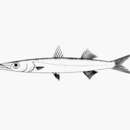en
names in breadcrumbs


The southern sennet (Sphyraena picudilla) is an ocean-going species of game fish in the barracuda family, Sphyraenidae. It was described by the Cuban zoologist Felipe Poey. The description was part of a two-volume work, which Poey published in 1860, entitled Historia Natural de la Isla de Cuba or Natural History of the Island of Cuba. Southern sennet are sometimes used as a food fish, and marketed either fresh or frozen.[1] Although they are generally harmless, Southern sennet have been linked to ciguatera poisoning.[2]
Southern sennet, like other members of the family Sphyraenidae, possess elongated bodies, pike-like heads, and large jaws.[3] The lower jaw protrudes slightly from the upper jaw, both of which contain fang-like teeth.[3] They have two dorsal fins, which are widely separated on their backs. The anterior dorsal fin usually possesses spines, while the posterior only has rays.[3] Southern sennet have six spines, and 9 rays on their dorsal fins. they have only two spines and 9 rays on their anal fins.[1] The longest recorded southern sennet was 2 ft long;[4] the greatest recorded weight was 2 lbs 8 oz.[4]
Southern sennet are known only from the western Atlantic Ocean from Bermuda, Florida, and the Bahamas south to Uruguay.[1] They are found in tropical climates from 32°N to 38°S. Southern sennet live in coastal waters near reefs, although they are more common over muddy bottoms,[5] at depths from 1–65 m,[6] where they often occur in large schools near the surface.[6] Juveniles are commonly found over beds of seagrasses.[6]
The southern sennet (Sphyraena picudilla) is an ocean-going species of game fish in the barracuda family, Sphyraenidae. It was described by the Cuban zoologist Felipe Poey. The description was part of a two-volume work, which Poey published in 1860, entitled Historia Natural de la Isla de Cuba or Natural History of the Island of Cuba. Southern sennet are sometimes used as a food fish, and marketed either fresh or frozen. Although they are generally harmless, Southern sennet have been linked to ciguatera poisoning.